Below is a transcript of a conversation Professor Tiago Fleming Outeiro at the KOL event
Introduction and Welcome
Hartaj Singh: Dr. Alcalay, thank you so much. This is Hartaj again, and I’m going to introduce the next speaker. We have Professor Tiago Fleming Outeiro. He’s a professor and director of the Department of Experimental Neurodegeneration at the University Medical Center in Germany. He’s also a professor at Newcastle University. His research interests are focused on the understanding of the molecular mechanism of neurodegenerative diseases, such as Parkinson’s, Huntington’s, and Alzheimer’s disease. Furthermore, he’s the chair of the task force and biological definition of Parkinson’s disease of the International Parkinson Movement Disorder Society. Please welcome Professor Tiago. Please take it away.
Overview of Parkinson’s Disease Research
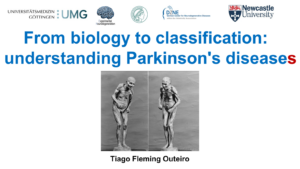
Professor Outeiro: Thank you so much for the introduction and it’s a pleasure to be with all of you today. What I’ll try to do over the next 20 minutes or so is to give you the perspective of a basic scientist about Parkinson’s disease. As you can see already here in my title, I wrote Parkinson’s disease, because as a follow-up to what we just heard from Dr. Alcalay, we think we are now in a position to distinguish different types of Parkinson’s disease, but that’s what I’ll come back to in the next few minutes.
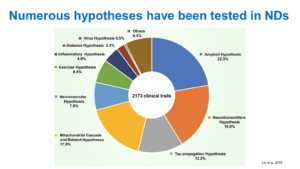
As a basic scientist, I’ve been looking at what’s been happening in the field of neurodegeneration for 25 years now, and with the data that are shown here for Alzheimer’s disease, we know that numerous hypotheses are being tested in thousands of clinical trials in Alzheimer’s, in Parkinson’s and other neurodegenerative diseases. And as a basic scientist, this is very frustrating, because so far, as you may know, we’ve only had limited successes. Success for disease-modifying therapies came about just in the past couple of years for Alzheimer’s disease, and these are not even perfect drugs, so there’s still a long way to go.
Understanding the Complexity of Parkinson’s Disease
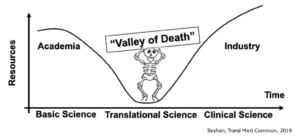
And as a basic scientist, as I was telling you, this seems rather frustrating. So we do a lot of research in academia and then we see that there’s this valley of death, where all the efforts and all the molecules that we discover and are sometimes so excited about in our work in the laboratory, fail to translate into medicines that clinicians can work to help their patients. So with this in mind, and because I work on Parkinson’s disease and here, of course, we already heard about Parkinson’s, I don’t need to spend any time explaining to you the disease, just to highlight that Jane Parkinson originally described the disease in 1817. So more than 200 years ago, when we still had a limited understanding of what was causing the disease. And this is because the disease is very complex.
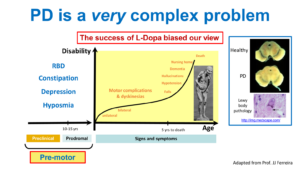
What you see here in this graph is the various signs and features of Parkinson’s disease across time. And in yellow, in this yellow box, you see the motor phase of the disease. We also heard before that there’s a pre-motor phase where you have non-motor symptoms that are now highly valuable for clinicians to detect and predict whether someone has an increased risk for developing Parkinson’s. But we’ve been very biased through the success of levodopa, which is the medication that all Parkinson’s patients end up taking, and this is because of the loss of the dopaminergic neurons in a region of the brain called the substantia nigra that you see here on the right side of the slide. In the Parkinson’s disease brain, you see that the neurons that used to carry a pigment that gives them the dark colour, died and disappeared. We know that the presence of aggregated Alpha-synuclein, a protein that is central in Parkinson’s disease, is also a hallmark of the disease.
Alpha-Synuclein and Neurodegeneration in Parkinson’s Disease
But when we think about Parkinson’s and all this complexity, we can easily realize that we may have a problem with the definition. It may not be enough to just think there is one Parkinson’s disease. And, therefore, we need to consider a variety of Parkinson’s diseases in much the same way as we think of cancer. There’s not just one type of cancer, there are multiple types of cancer. And we think that this concept may apply also to Parkinson’s disease.

And, as a biologist, and a scientist, I’m interested in understanding the possible pathogenic mechanisms, and this is a schematic already from six or seven years ago, that shows different pathways that we know can contribute to neurodegeneration, which is the endpoint that leads to the motor problems in Parkinson’s disease.
You see here on the left side, Alpha-synuclein. So there is mutant Alpha-synuclein in some cases. In many cases, there’s modified and misfolded Alpha-synuclein. And eventually, this protein seems to accumulate in most of the patients with Parkinson’s disease. And we know a lot about this protein, I will not bore you with details about this protein, just to say that this is an abundant protein in the brain. But we need to keep in mind that this protein exists also outside of the brain, including the blood, in red blood cells and in others as well.
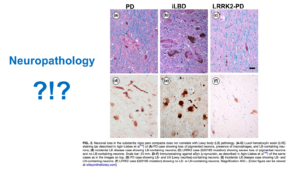
And when we think about neuropathology in Parkinson’s disease, things are not always as clean as we would have hoped. What I mean by this is that we have the typical Parkinson’s disease cases where one can use the microscope to detect the accumulation of aggregated Alpha-synuclein in the typical inclusions known as Lewy bodies, but then there’s also cases of people that never showed during their life any signs of Parkinson’s disease and upon autopsy, neuropathologists look in the brain and just by chance, they probe for Alpha-synuclein and they find Alpha-synuclein staining. So they find Lewy bodies, and they’re quite puzzled, why would this protein that we think is associated with Parkinson’s be accumulating also in the brains of people who never showed any signs of Parkinson’s, this is puzzling.
And then there are also other types of intriguing cases. In this case, there are some genetic forms of Parkinson’s disease. The one I’m showing you here is a LRRK2 case, so people that have typical symptoms of Parkinson’s. And when your pathologist looks at this tissue, upon autopsy, they find no Lewy bodies. So this shows you that you can have Parkinson’s disease and not have necessarily Alpha-synuclein accumulation in the brain. These images were kindly provided by Dr. Junko von Sotell, from the Columbia Brain Bank, through Dr. Roy Alcalay who was a co-author with me on this study.
Advancements in Biomarkers and Neuroimaging Techniques
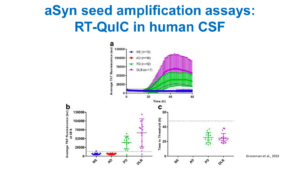
Now, as we also heard from Dr. Alcalay, we are in a privileged position because now after the work of many groups throughout the world, and also with the effort of all the groups that contributed to this large cohort called PPMI, the Michael J. Fox Foundation is leading, there is an assay that is a biomarker for this pathological Alpha-synuclein. So we can detect pathologic Alpha-synuclein very specifically in people that have Parkinson’s or some of the related disorders. And this is the study that I show you here, that opened lots of possibilities in the field.
Now, neuroimaging is also a very useful tool, it’s used for many other diseases. And in Parkinson’s, there are also, at the moment, some imaging techniques that enable clinicians to detect the loss of signal in the brain that is associated with Parkinson’s disease. But at the same time, there are also those exceptions where people don’t show any alteration in this brain imaging approach, but people still show more symptoms. So again, neuroimaging is great, it’s a great tool, but it’s not perfect. Some cases are always the exceptions.
Incorporating Genetics and Clinical Information in Parkinson’s Disease
We know we’re all different, we heard a lot about genetics. There are even additional layers of complexity that we are still not even understanding in detail, and these are words like epi genetics, epi transcriptomics, things and concepts that I will not get into today, but that could and hopefully in the future will enable us to incorporate this information in the classification systems we’re using.
Biological Definition and Classification of Parkinson’s Disease
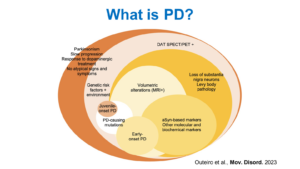
And a few years ago, I started working with other colleagues, including Dr. Roy Alcalay, on this task force on the biological definition of Parkinson’s. We published an initial study, basically identifying the need for defining the disease better than what we’ve been doing so far, which has been using clinical observation. And just because something manifests in a certain way, it does not mean that it’s always the same thing. So this is what I mean here with this riddle that I created to convey the idea that there may be more than one Parkinson’s disease.
In that same paper, we published this schematic that tries to convey the idea that now we have different layers that we can use to try to define Parkinson’s. These include genetics, neuroimaging, biomarkers, the clinical information. So all of these are very useful for clinicians to know what type of patient they have in front of them when they come to see them. So we want to classify the disease better. And why would we need to do this? Well, from my perspective, as a scientist, this will be very important because if we know what types of Parkinson’s disease we have, we will be able to develop better models of Parkinson’s, which in turn will enable us to test and perhaps be more successful in developing effective therapeutic strategies. Then, this will also enable clinicians to select patients that are more suitable for a certain type of intervention in a clinical trial. And eventually, this will be very useful as we heard from Dr. Alcalay for precision medicine.
The Evolving Nature of Parkinson’s Disease Research
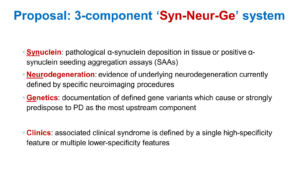
So we published in the context of another group of experts that was led by Dr. Anthony Lange and Gunter Hunklinger, we published this proposal for a biological classification that is based on information that we have accessible today, and these are the main points, the main components of this classification system. So we use information related to the pathological status of Alpha-synuclein, and information regarding the neurodegeneration status based on imaging. And then genetics, as we heard in the previous talk, genetics can also help us distinguish different forms of Parkinson’s. The clinical information is, of course, very useful.
So basically, what we propose is that we are now in a position to identify genetic factors to distinguish whether they are familial factors or just predisposition risk factors. We can distinguish whether a patient has pathological Alpha-synuclein or not, whether they have neurodegeneration or not, and then the clinical status, whether the motor symptoms are present or still not present. With all this in mind, we are then in a position to classify and distinguish patients.
Now, we want to also make this an evolving concept. The idea is that as new biological information becomes available, we will be able to incorporate this into this classification system. And this one that we just proposed recently is version one, but there will be version two and version three and so on, as new information from different biomarkers becomes available.
Research on Alpha-Synuclein and Expansion Microscopy
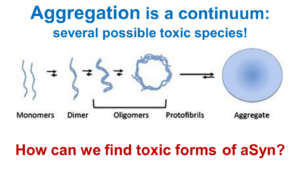
And now, as a scientist, I want to just give you a quick glimpse into some exciting work we are doing focusing on Alpha-synuclein. We are always asking this question, why does this protein Alpha-synuclein become toxic? And how does it cause synucleinopathies? We think it is because it aggregates and accumulates in the brains of patients in a process that we don’t fully understand, but we think goes more or less like this. You start with a single protein, and then the protein starts to come together and clump, eventually forming the aggregate that we find in the brains of patients upon autopsy. And the question for us scientists is, how can we look into a brain or cells and find toxic forms of Alpha-synuclein? These are very tiny, so you know that if you need to look at the stars and the planets, you use telescopes. If you need to look at cells, you need to use microscopes. But if you need to look at proteins, which is what we’re trying to do, you need to use special types of microscopes that we now call nanoscopes, because they allow us to see even smaller objects.
And one of the techniques we’re using is called expansion microscopy. And this is based on the same principle that is in baby diapers where you have a matrix that absorbs liquid, and that keeps the liquid. So applying this idea, we are now in a position where we can expand our specimens in the laboratory, whether they are cells or brain slices, we can expand them physically and separate the objects that were once so close together that we could not distinguish them. And now we make them bigger, and we can use microscopes to see them better.
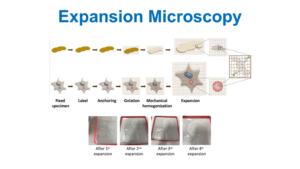
I’ll just show you here without boring you with a lot of details, that now basically we can see objects that we could not see before. So we see here, these structures that we call large inclusions or ring-like inclusions, and we’re very excited about this because this is now allowing us to see the architecture of those inclusions that we could not even detect before. And so we think that if we now apply this technique to blood samples or CSF samples from patients, we might be able to distinguish structures with different shapes in patients versus controls.
Exploring Lipids and New Therapeutic Approaches in Parkinson’s Disease
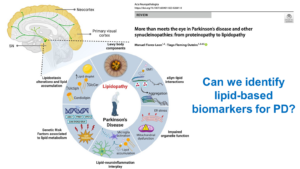
But there is a future beyond Alpha-synuclein. As I told you, the pathophysiological mechanisms are highly complex, so we need to think beyond Alpha-synuclein. And we need to think beyond this idea that Parkinson’s is just a proteinopathy where there are problems with proteins. We know there are problems with lipids, and this is another publication we just published recently, where we propose that we need to look at lipids. And this is based of course on the work of many in the field, including the beautiful work by Dr. Alcalay over the years that suggests that we need to identify maybe lipid-based biomarkers for Parkinson’s disease.
And the therapeutic strategies that we can use you already heard about. This is the single lipid metabolism and how this impacts this important process in the cell called autophagy that enables proteins to be degraded in structures called lysosomes. And we now have various tools that enable us to tackle this pathway. The molecule that you’ll hear more about in the next presentation is an exciting molecule because it seems to be able to stabilise the glucocerebrosidase protein that is defective when you have mutations.
Conclusion
So with all of this in mind, what we want to do as scientists in the lab is to understand this underwater part of the iceberg, which is the largest part, is biology, because we think that this is what we need to do in order to have effective therapies in the future. So we want to target this part and not just the clinical symptoms.


